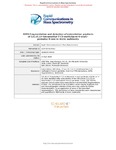EIMS Fragmentation and detection of autoxidation products of 2,6,10,14‐tetramethyl‐7‐(3‐methylpent‐4‐enyl)‐pentadec‐5‐ene in Arctic sediments
| dc.contributor.author | Rontani, J | |
| dc.contributor.author | Smik, L | |
| dc.contributor.author | Belt, Simon | |
| dc.date.accessioned | 2020-04-24T13:48:56Z | |
| dc.date.issued | 2020-04-21 | |
| dc.identifier.issn | 0951-4198 | |
| dc.identifier.issn | 1097-0231 | |
| dc.identifier.other | ARTN e8816 | |
| dc.identifier.uri | http://hdl.handle.net/10026.1/15595 | |
| dc.description | 12 months embargo applied | |
| dc.description.abstract |
<jats:sec><jats:title>Rationale</jats:title><jats:p>Some highly branched isoprenoid (HBI) alkenes are commonly used as proxies for palaeoceanographic reconstructions. However, there is a need to identify compounds that are sufficiently stable and abundant to be used as tracers of HBI oxidation in sediments. 2,6,10,14‐Tetramethyl‐7‐(3‐methylpent‐4‐enyl)‐pentadec‐5(<jats:italic>Z/E</jats:italic>)‐en‐4‐ols resulting from 2,6,10,14‐tetramethyl‐7‐(3‐methylpent‐4‐enyl)‐pentadec‐5‐ene appear to be useful for this purpose.</jats:p></jats:sec><jats:sec><jats:title>Methods</jats:title><jats:p>Comparison of electron ionization (EI) mass spectra and retention times with those of standards allowed formal identification of autoxidation products of 2,6,10,14‐tetramethyl‐7‐(3‐methylpent‐4‐enyl)‐pentadec‐5‐ene. EI‐MS fragmentations of TMS ethers of the main oxidation products (2,6,10,14‐tetramethyl‐7‐(3‐methylpent‐4‐enyl)‐pentadec‐5(<jats:italic>Z/E</jats:italic>)‐en‐4‐ols) were deduced by gas chromatography/electron ionization mass spectrometry (GC/EI‐MS), low‐energy collision‐induced dissociation tandem mass spectrometry (CID‐MS/MS) and accurate mass measurements. These compounds were then quantified in Arctic sediment samples in MS/MS multiple reaction monitoring (MRM) mode using transitions based on the main fragmentation pathways elucidated.</jats:p></jats:sec><jats:sec><jats:title>Results</jats:title><jats:p>2,6,10,14‐Tetramethyl‐7‐(3‐methylpent‐4‐enyl)‐pentadec‐5(<jats:italic>Z/E</jats:italic>)‐en‐4‐ols were identified after autoxidation of the HBI alkene 2,6,10,14‐tetramethyl‐7‐(3‐methylpent‐4‐enyl)‐pentadec‐5‐ene. Low‐energy CID‐MS/MS analyses and accurate mass measurements allowed the EI‐MS fragmentation pathways of their trimethylsilyl (TMS) derivatives to be elucidated. Some specific fragment ions and chromatographic retention times were also useful for further characterization. As an application of some of the described fragmentations, TMS derivatives of these metabolites were characterized and quantified in MRM mode in Arctic sediments.</jats:p></jats:sec><jats:sec><jats:title>Conclusions</jats:title><jats:p>Due to their production in high proportions during autoxidation of their parent HBI diene, their apparent stability in sediments, and their specific EIMS fragmentations, (<jats:italic>Z</jats:italic> and <jats:italic>E</jats:italic>)‐2,6,10,14‐tetramethyl‐7‐(3‐methylpent‐4‐enyl)‐pentadec‐5‐en‐4‐ol TMS derivatives appeared to be useful tracers of HBI autoxidation in sediments.</jats:p></jats:sec> | |
| dc.format.extent | e8816- | |
| dc.format.medium | ||
| dc.language | en | |
| dc.language.iso | en | |
| dc.publisher | Wiley | |
| dc.title | EIMS Fragmentation and detection of autoxidation products of 2,6,10,14‐tetramethyl‐7‐(3‐methylpent‐4‐enyl)‐pentadec‐5‐ene in Arctic sediments | |
| dc.type | journal-article | |
| dc.type | Journal Article | |
| plymouth.author-url | https://www.webofscience.com/api/gateway?GWVersion=2&SrcApp=PARTNER_APP&SrcAuth=LinksAMR&KeyUT=WOS:000553433700003&DestLinkType=FullRecord&DestApp=ALL_WOS&UsrCustomerID=11bb513d99f797142bcfeffcc58ea008 | |
| plymouth.issue | 15 | |
| plymouth.volume | 34 | |
| plymouth.publication-status | Published | |
| plymouth.journal | Rapid Communications in Mass Spectrometry | |
| dc.identifier.doi | 10.1002/rcm.8816 | |
| plymouth.organisational-group | /Plymouth | |
| plymouth.organisational-group | /Plymouth/Faculty of Science and Engineering | |
| plymouth.organisational-group | /Plymouth/REF 2021 Researchers by UoA | |
| plymouth.organisational-group | /Plymouth/REF 2021 Researchers by UoA/UoA07 Earth Systems and Environmental Sciences | |
| plymouth.organisational-group | /Plymouth/Research Groups | |
| plymouth.organisational-group | /Plymouth/Research Groups/Marine Institute | |
| plymouth.organisational-group | /Plymouth/Users by role | |
| plymouth.organisational-group | /Plymouth/Users by role/Academics | |
| plymouth.organisational-group | /Plymouth/Users by role/Researchers in ResearchFish submission | |
| dc.publisher.place | England | |
| dcterms.dateAccepted | 2020-04-17 | |
| dc.rights.embargodate | 2021-4-21 | |
| dc.identifier.eissn | 1097-0231 | |
| dc.rights.embargoperiod | Not known | |
| rioxxterms.versionofrecord | 10.1002/rcm.8816 | |
| rioxxterms.licenseref.uri | http://www.rioxx.net/licenses/all-rights-reserved | |
| rioxxterms.licenseref.startdate | 2020-04-21 | |
| rioxxterms.type | Journal Article/Review |


